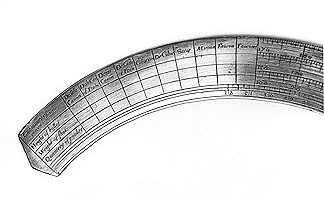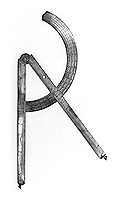 Fig. 13
Fig. 13  Fig. 14
Fig. 14
c. 1600
Large guns of the Renaissance came in a bewildering variety of forms. They were variously categorized by their length, their weight and the size or weight of the shot they fired. Each gun was unique because, after it had been cast from bronze or iron, its mould had to be smashed to extract the piece. But although standardization was not possible, different types of 'great ordnance' were recognized and named. To keep track of the interrelations between powder, shot and piece, gunners and administrators compiled tables listing the ammunition and supplies appropriate to each gun. Such aides-mémoire became standard features of manuscript and printed works, but instruments also regularly served as a convenient and robust location for them.
The arc of this early English sector carries an artillery table drawn up to record the size and weight of shot and the amount of powder required for different types of artillery. The table's data were never entered but 'The names of peeces' were listed in order of decreasing size: double cannon, double cannon of France, demi-cannon, demi-cannon of France, culverin, demi-culverin, saker, minion, falcon and falconet.
The sector was a new instrument of the late 16th century, first publicized in a book by Thomas Hood published in London in 1598. Equipped with sights for use by surveyors it was also provided with various engraved scales for calculation and measurement. This unsigned English example is closely related to the form described by Hood and includes sectoral scales for the graphical calculation of proportions and for drawing polygons. The reverse of its arc carries a scale of degrees, subdivided by transversals for greater precision, along which is an additional series of points for setting out polygons.
Leg length (closed): 279 mm
Inventory no. 44,505